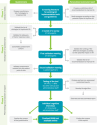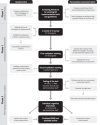Reflective Tool on Advanced Access to Support Primary Healthcare Teams: Development and Validation of an Online Questionnaire
- PMID: 39526335
- PMCID: PMC12421708
- DOI: 10.1111/jep.14232
Reflective Tool on Advanced Access to Support Primary Healthcare Teams: Development and Validation of an Online Questionnaire
Abstract
Rationale: Awareness of their standing relative to best practices motivates primary healthcare (PHC) teams to improve their practices. However, gathering the data necessary to create such a portrait is a challenge. An effective way to support the improvement of the practices of PHC teams is to simplify the availability of data portraying aspects of their practices that might need improvement. Timely access is one of the foremost challenges of PHC. Yet, very few tools supporting reflections on the implementation of best practices to improve access are available to PHC teams.
Aims and objectives: To develop an online reflective tool that evaluates the state of a PHC team member's advanced access practice and formulates customized recommendations for improvement.
Methods: This sequential multimethod study was informed by a literature review and an expert panel composed of researchers, patients, provincial and local decision-makers, and PHC clinical and administrative staff in the province of Quebec, Canada. Consensus was reached on the content of the questionnaire and the prioritization of the recommendations.
Results: No reflective tool on advanced access practices was found in the literature review. Grey literature was used to create an initial version of the questionnaire. This version was revised and enriched through consultation phases with the expert panel. Then, five iterations of the tool were tested with 169 PHC team members, which led to the conception of two distinct versions: one for clinical staff and one for administrative agents responsible for appointment booking. The final versions of the reflective tool are available online in both English and French.
Conclusion: This reflective tool provides a portrait of PHC team members' advanced access practices as well as an automated report that contains personalized and prioritized recommendations for improvement. Further developments are necessary for its optimal use among PHC professionals other than physicians and nurse practitioners.
Keywords: Canada; access to care; primary health care; quality improvement; questionnaire design; self‐assessment; survey.
© 2024 The Author(s). Journal of Evaluation in Clinical Practice published by John Wiley & Sons Ltd.
Conflict of interest statement
The authors declare no conflicts of interest.
Figures





References
-
- Sargeant J., Bruce D., and Campbell C. M., “Practicing Physicians' Needs for Assessment and Feedback as Part of Professional Development,” Journal of Continuing Education in the Health Professions 33 (2013): S54–S62. - PubMed
Publication types
MeSH terms
Grants and funding
LinkOut - more resources
Full Text Sources

